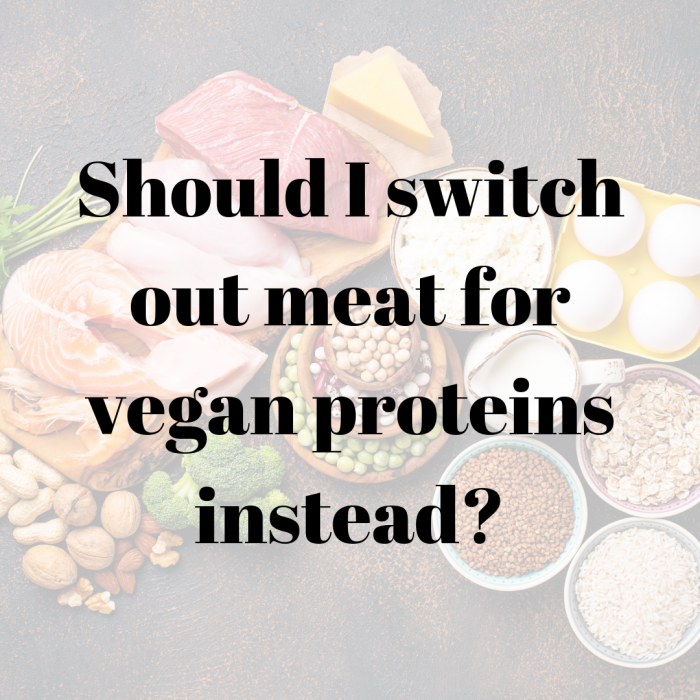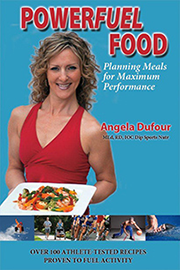Should I switch out meat for vegan proteins instead?
Submitted by Angela on August 22, 2019 - 1:52pm


Interest in plant-based foods and more plant based ways of eating is at an all-time high and is increasing worldwide.1 Canada’s new 2019 food guide states: “Choose protein foods that come from plants more often. Plant-based protein foods can provide more fibre and less saturated fat than other types of protein foods. This can be beneficial for your heart health”.2
What foods count as plant based proteins?
Plant proteins include:
- nuts and seeds (e.g. almonds, cashew butter, sunflower seeds, and pumpkin seeds),
- soy (e.g. tofu, soybeans, fortified soy milk, and edamame), and
- legumes (e.g. kidney beans, split peas, chickpeas, and lentils).
Are these plant proteins healthier than animal proteins?
Think of each food item not just as a “protein”. Instead, look at it as the overall nutrition “package” it delivers and whether or not that meets your individual health needs: 3
|
Source |
Protein (g) |
Saturated fat (g) |
Sodium (mg) |
Omega 3 |
Vitamin D |
Fibre (g) |
B124 (mcg) |
Iron (%DV) |
|
4oz broiled sirloin steak |
33 |
5 |
Variable/ Medium |
- |
Lowest |
- |
2.0-4.0 |
~20 |
|
4oz ham steak |
22 |
1.6 |
High (1500) |
- |
Low |
- |
1.1 |
~10% |
|
4oz grilled sockeye salmon |
30 |
1 |
Variable/ Low |
High |
High |
- |
7 |
~4% |
|
1 cup cooked lentils |
18 |
- |
Lowest |
- |
- (None) |
15 |
- |
~20% |
You can see that every animal protein has a different mix of nutrients, and of saturated fat and/or sodium content depending on the method of preparation. Plant proteins, such as the lentils, would be much better than the ham steak due to the minimal sodium. The lentils could also be considered “better” due to high fibre content! However, if we look at sirloin steaks, they do contain heme iron (found only in animal products and is better absorbed than non-heme/plant iron) and vitamin B12, which can help prevent anemia. As well, the salmon has its unique benefits: omega-3s which help heart and brain health, and a high vitamin D content to help maintain strong muscles and bones!
The bottom line is that animal and plant proteins BOTH can play a role in a healthy omnivore diet. Animal proteins do, on average, contain more saturated fats and cholesterol, so choosing leaner cuts and swapping a few meat meal options with plant-based options may be beneficial to reducing the risk of some chronic diseases (such as cardiovascular disease and type II diabetes).5
Ok, so not all meats are good, but are all plant protein foods healthy?
Well, no, not exactly - there are a couple things to keep in mind when choosing your source.
- Most plant proteins are considered “incomplete” (other than quinoa or soy). This means it is even more important to try and get a variety of different protein sources in your diet, rather than focusing on only eating black beans for example. Whole grains also make up a significant part of your protein intake.
- Watch out for any added sugar, salt, fat, or additives inside your product. Make sure you practice the following: 2
- Pick low sodium canned beans, peas, or lentils or rinse then drain canned items prior to use.
- Choose roasted nuts and seeds without any added sugars, fat (oils), or sodium (salt).
- Pick nut butters with nuts as the only or close to the only ingredient with little to no added sodium, sugar, or saturated fat (e.g. go for a natural peanut butter instead of those with added sugar/salt).
But aren’t vegan proteins “specialty” and more expensive than meat?
Well, a recent study of 1017 Canadians by Dalhousie University found that the largest barrier to the use of Canada’s new Food Guide was the perception that recommendations were not affordable.6 The opposite is true though! Following Canada’s 2019 Food Guide would save “Canadian families, on average, 6.8% of their annual food costs” compared to the 2007 Food Guide due to the emphasis on plant foods.6
Similar findings were presented in a 2015 study that compared the cost of an economical 7-day omnivore meal plan from MyPlate (MP) to a vegetarian meal plan using olive oil (PBOO). MP ended up costing close to $750 more per year than PBOO, the vegetarian diet that still used expensive olive oil. Both meal plans had sufficient protein levels, but the vegetarian diet had around 30 grams less for a day.7 However, the PBOO included more vegetables, fruits, and whole grains.7
A bad rap for vegetarian/vegan diets likely comes from the cost of processed food products, with dairy-free cheese, mock meats, and other specialty items costing a lot more than their animal-based counterparts. However, one casual look into protein prices in one area of the U.S. showed that some common whole plant protein foods were quite cheap, and ranged from 0.7 cents/ gram protein for rolled oats, to 1.1 cents/ gram protein for dry beans, and to 1.9 cents/ gram protein for brown rice.7 On the other hand, meat ranged from 1.5 cents/ gram protein for chicken, to 2.7 cents/ gram protein for milk, and to 4.5 cents/ gram protein for steak.8
Looking at these numbers, you can see how you could eat a vegetarian/ vegan diet on a much smaller budget. However, there are a few plant protein options that have other health benefits such as chia seeds (13 cents/gram protein) and hemp seeds (11 cents/ gram protein) that are recommended to balance out your diet.8
The prices are comparable, with vegetarian/vegan diets being potentially more economically sustainable. Ways to improve affordability would be to choose less processed non-convenience versions. Even, for example, dried beans can be used instead of canned beans to reduce costs. They do take a bit more work such as soaking overnight and cooking afterwards, but they are a cheap option.
Are fake meat burgers really better than my usual all-beef patties?
The Beyond Meat’s “Beyond Burger” is one product in a series of faux-meat products designed to get you eating more plant proteins! However, is it really healthier? Well, the newly released upgraded version has a blend of peas, mung bean, and rice to provide a complete protein source.9 Compared to beef patties, there are these supposed pros and cons:
PROS: no soy, no gluten, no GMOs, no cholesterol
CONS: shelf stabilizers, highly processed with almost 20 ingredients (more ingredients however does not always = unhealthier; it depends on what is used)
REMEMBER: While Canada’s food guide recommends consuming more plant-based protein products over just meats, it is moreso referring to whole foods such as beans and lentils and not pre-packaged processed products. There are a lot of unnecessary, extra ingredients put inside to make the burger look and feel like meat.
These are potentially healthier versions of what should be a “once-in-a-while” food item. One thing we tell people to watch out for is seeing these products with a “health halo” (perceiving them as “healthy” products), which may cause overindulging. It is important to remember they still have higher amounts of calories, sodium, and saturated fat. For example, one thin patty takes up 16% of your daily sodium intake without any salt you might add on top.9 For reference, for any product ≤5% is considered low, while ≥20% is considered high.
Make sure whichever you choose, that you consume in moderation!
Your run-of-the-mill “veggie burger”? The benefits and drawbacks are similar to those listed above for the faux meat burger. Some other veggie burgers may be suitable for vegetarians with soy or pea protein allergies. In general, soy veggie burgers may be slightly higher in calcium, protein, or iron content than typical bean-based veggie burgers. Compared to beef patties, there are these supposed pros and cons for veggie burgers:
PROS: ↓ saturated fat, ↓ calories, ↑ fibre.
CONS: ↑ sodium, ↓ protein content, ↑ artificial ingredients (fillers, preservatives, and flavouring/ colouring agents)
Lastly, chicken or turkey burgers may be a good option to cut down on saturated fats, but, as always, it is important to keep the ingredient list in mind. Either way, the best option would be to make your own burger at home! You can use the ingredients mentioned or use tofu, white beans, nuts, quinoa, and/or portobello mushrooms (combine this choice with a protein side) for a homemade veggie burger. You can also mix animal and plant proteins to make your own unique recipes with a whole range of nutrients! One easy way to cut down on the meat in burgers is to mix it with grains (such as bulgur or oats) or with sweet potato.
|
Source (4oz of) |
Calories (kcal) |
Protein (g) |
Saturated Fat (g) |
Sodium (mg) |
Iron (% DV) |
|
Broiled sirloin steak |
214 |
33 |
5 |
Variable (~280) |
~20 |
|
Beyond meat burger |
250 |
20 |
6 |
390 |
25 |
|
Quinoa veggie burger10 |
224 |
8 |
0.8 |
720 |
10 |
|
Black bean veggie burger11 |
183 |
15 |
0.8 |
533 |
13 |
|
Turkey burger12 |
160 |
21 |
2.4 |
496 |
3 |
Take-home message
Adding more plant-based proteins into your diet may improve your health and reduce your risk of several chronic illnesses. However, there is no need to adopt a vegetarian diet if you don’t want to! Vegetarians may have better health than that of the general population just due to more awareness for healthy choices, rather than due to an inherent advantage of consuming only plant proteins over a mix of plant and animal proteins. Balance out your meals and be mindful of what you eat!
References
1 Oberst L. 2018. Why the Global Rise in Vegan and Plant-Based Eating Isn’t A Fad (600% Increase in
U.S. Vegans + Other Astounding Stats). Food Revolution Network. Retrieved from: https://foodrevolution.org/blog/vegan-statistics-global/
2 Government of Canada. 2019. Canada’s Food Guide: Eat protein foods. Retrieved from: https://food-
guide.canada.ca/en/healthy-eating-recommendations/make-it-a-habit-to-eat-vegetables-fruit-whole-grains-and-protein-foods/eat-protein-foods/
3 Harvard T.H. Chan. 2019. Protein. The Nutrition Source. Retrieved from:
https://www.hsph.harvard.edu/nutritionsource/what-should-you-eat/protein...
4 Dietitians of Canada. 2016. Food Sources of Vitamin B12. Dietitians of Canada. Retrieved from:
https://www.dietitians.ca/getattachment/45413d68-0639-4ad6-8de6-10eb9755...
5 PEN. 2015. Vegetarianism: Summary of Recommendations and Evidence. Retrieved from:
https://www-pennutrition-com.ezproxy.msvu.ca/KnowledgePathway.aspx?kpid=...
&trid=3216&trcatid=42
6 Dalhousie University & the University of Guelph. 2019. Canada’s Food Guide: Awareness,
Understanding, Affordability, and Barriers to Adoption (Preliminary Results). Retrieved from: https://cdn.dal.ca/content/dam/dalhousie/pdf/management/News/Canada%20Fo...
7 Flynn MM & Schiff AR. 2015. Economical Healthy Diets (2012): Including Lean Animal Protein
Costs More Than Using Extra Virgin Olive Oil. J Hunger Environ Nutr. 10 (4): 467-482.
8 PlenteousVeg. 2014. Cost of Vegan Protein vs. Animal Protein. Retrieved from: https://plenteous
veg.com/cost-vegan-protein-vs-animal-protein/
9 BEYOND BURGER™. 2019. Beyond Meat. Retrieved from: https://www.beyondmeat.com
/products/the-beyond-burger/
10 Amy’s kitchen. 2019. Sonoma Veggie Burger. Retrieved from: https://www.amyskitchen.ca
/products/product-detail/veggie-burgers/000373F
11 Morningstar Farms. 2019. Morningstar Farms® spicy black bean burgers. Morningstar Farms.
Retrieved from: https://www.morningstarfarms.com/products/morningstar-farms-spicy-black-...
12 President’s Choice. 2019. PC Blue Menu Thick & Juicy Turkey Burgers. President’s Choice.
Retrieved from: https://www.presidentschoice.ca/en_CA/products/productlisting/pc_blue_menu_
thick_juicy_turkey_burgers19350.html


